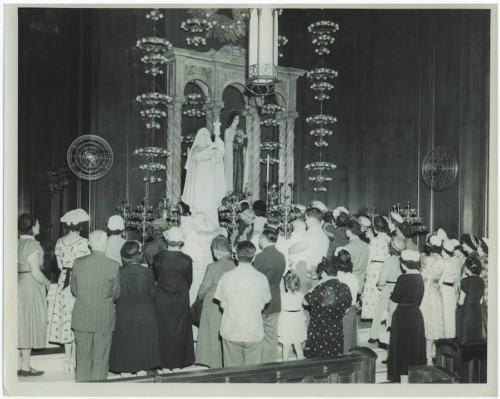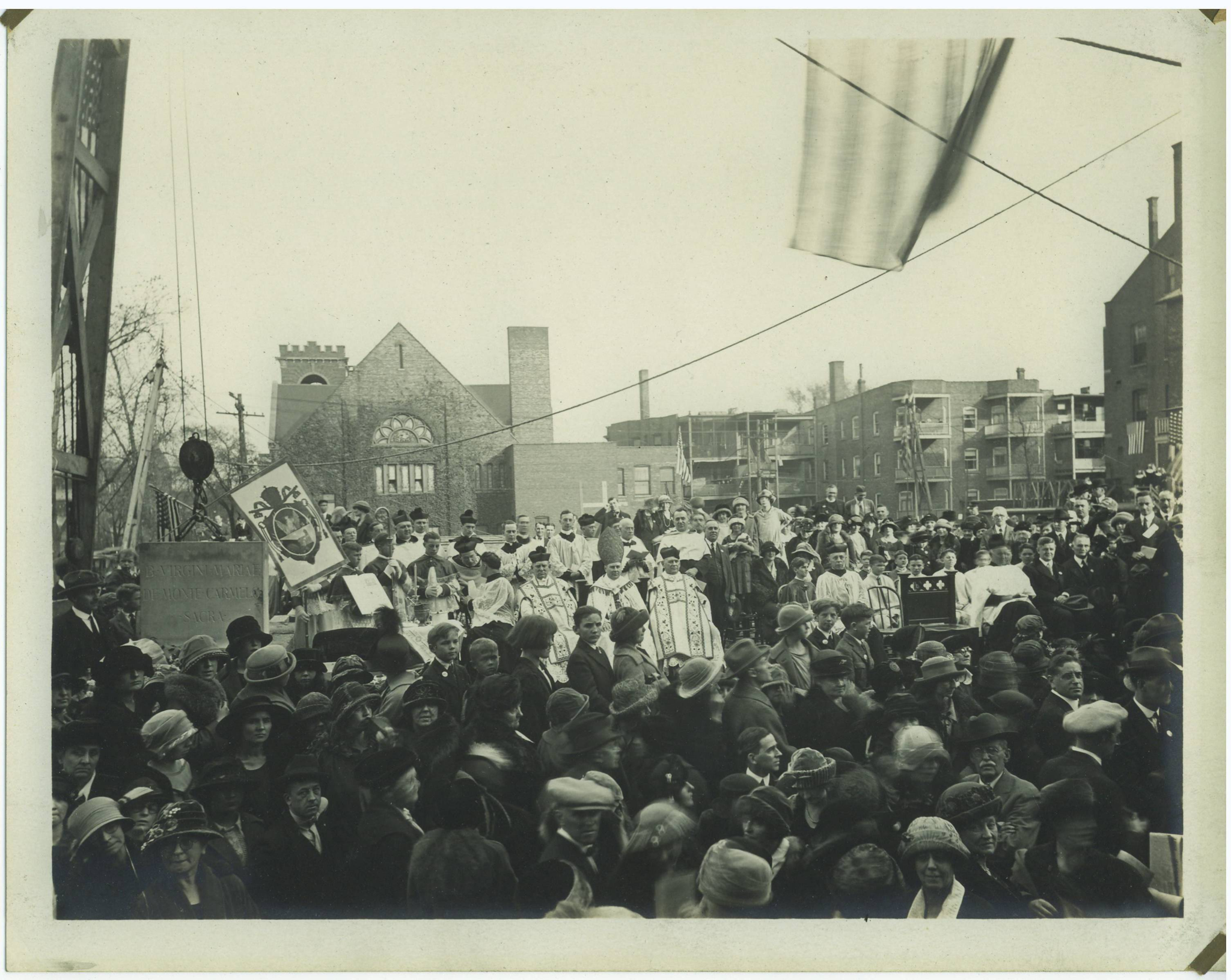When fire struck Woodlawn’s Shrine of Christ the King last October, it took less than two months for the Archdiocese of Chicago to file for permits to tear down the nearly one-hundred-year old building, which stands at the corner of 64th and Woodlawn.
A $6 million renovation esoject on the church had nearly finished when an oily rag, left in the building from the last of the construction work, caught fire by accident. The fire destroyed most of the building’s interior, the roof, and some of its windows. In December, the Archdiocese filed for demolition permits and explained in a letter to the Shrine’s canon that reparations for the burned building were “cost-prohibitive.”
Neither the fire nor the threat of demolition was unprecedented for Shrine: it burned down once before in 1976, in a suspected arson. The church’s interior, known to have been just as glorious as its outside walls, has never been fully
rebuilt.
Several Catholic parishes used the church in the latter half of the twentieth century. As Woodlawn’s demographics changed, and Catholic immigrant groups moved out of what had once been a majority-Irish neighborhood, these parishes lost significant membership. By 2003, there were so few practicing Catholics in the area that the Archdiocese decided to close the parish and demolish the building. Preservationists mobilized and obtained historic landmark status for the building in 2004. The Archdiocese then gave the building to the Institute of Christ the King, an order of priests based in Italy, of which Shrine of Christ is the U.S. headquarters, effectively saving it. The parish moved into the building in 2007.
In February of this year, two months after being threatened with demolition for the second time this century, the church was saved once again: on February 26, the Archdiocese transferred the deed to the care of the Institute, allowing the parish to focus on rebuilding the church. The decision came soon after the Coalition received anonymous donations of $400,000 and $250,000, in addition to the $68,000 they had already raised from more than 580 other donors. The Coalition to Save the Shrine, as the group of organizers is officially called, has since continued to raise money to help with the reconstruction of the building.
“One of the wonderful things about this story is that for many of the people involved, this was their second save,” said parishioner Emily Nielsen, who lives in Winnetka but comes to the Shrine for mass every Sunday.
So how did lightning strike twice?
Activism has a long history in Woodlawn: resident Gabriel Piemonte calls the neighborhood an “organizers heaven—a million people doing a million things.” When Piemonte heard around Christmastime last year that the Archdiocese had filed a permit to demolish a building many Woodlawn residents consider a staple of their community, he and his neighbors began organizing right away.
“When we heard [about the demolition] we were blown away,” said Piemonte. “Obviously we needed to mobilize and be there, to speak up.” The Commission on Chicago Landmarks, which reviewed the Archdiocese’s demolition permits, told the community that it was too late to save the building, as the review was just a formality, and the decision would be made only at the discretion of the Commission’s staff.
“Of course, as good Chicagoans, we ignored this,” said Piemonte. Parishioners and community members began taking the Commission’s comment cards and filling them in, staging protests, and sending letters to the Archdiocese’s office asking them to reconsider tearing down the building. They were confident that organizing on such a large scale for one building would prove effective. “We started with the sense that although we had a very strong landlord with different ideas than ours, there was at least a chance we might be able to get public support on our side,” said Piemonte.
Support for the protestors grew quickly. As the Archdiocese moved to demolish the building— by January the Archdiocese’s office had specific plans for which portions of the building would come down on which days—the group of protestors organized as the Coalition to Save the Shrine, started an online fundraiser, advertised the cause locally on posters and in newspapers, and invited the press to their rallies. People from around the world wrote letters in support of the Coalition. Meanwhile, the group’s core focused on efforts to portray the architectural gem as essential to the neighborhood’s wellbeing.
“The way we framed it to our neighbors was ‘Why are we creating more empty lots in Woodlawn?’” said organizer and Woodlawn resident Mike Medina.
Medina, whose family moved to Woodlawn just after the Shrine of Christ parish moved into the building, explained that urgency surrounding demolition stemmed primarily from residents’ relationship with parishioners. When the Woodlawn block club could not find a place to meet, for example, the parish lent the club space in the church.
“[When we moved here] we became friends with the Canons that run it and the parishioners and they were just being good neighbors, not pontificating or trying to spread an agenda,” said Medina. “It was just ‘Hey, come see the place.’ So when the fire happened, our reaction was immediate. Whatever it was they needed us to do, we were going to try to do it.”
“There’s a relationship that has strengthened because of this crisis but was already there,” Piemonte agreed. “These [parishioners] are needed in our neighborhood and if they’re being threatened we’re being threatened, because in our community we’re sensitive to issues surrounding development, so this feels very familiar to us.”
Even the local café got involved: employees from Robust Coffee, which stands a block north of the Shrine, brought coffee to the Canons the day of the fire, and parishioners often gather at Robust after Sunday mass. Many community members say that business from parishioners, most of whom live in other parts of Chicago or in suburbs more than an hour away, helps keep the coffee shop open.
The residents’ appreciation for the parishioners is reciprocated: “They have been fabulous,” said parishioner and Coalition member Mary Kubacki. “I just can’t say enough nice things about them. Our church is part of their community, but all of us were amazed at how they went to bat for us. People from the neighborhood would see us out front and they would say ‘we’re praying for you,’ and a lot of these people weren’t even Catholic.”
Though many of these parishioners live in suburbs an hour or more away from Chicago, the beauty of the building brings them into the city every week. Built in the 1920s, the Shrine was designed by Henry Schlacks, an esteemed Chicago architect who designed more than fifteen churches and went on to found the architecture school at Notre Dame. What is now the Shrine of Christ is among his most admired works, and has always attracted large crowds.
Kubacki, who lives in West Joliet, drives an hour to mass with her family on Sundays. “It’s worth every second in the car,” she says. “The building itself is an extraordinary piece of history.”

While the Archdiocese has not publicly explained its decision to cancel the demolition, Coalition-members assume that the large anonymous donations, most likely from philanthropists concerned about preservation of a revered piece of architecture, had at least as much influence as the work of Woodlawn residents and parishioners.
So while the people Kubacki calls the Coalition’s “foot soldiers” were mostly residents or parishioners, the building’s history proved significant enough for those without a stake in Woodlawn, or even the Shrine specifically.
Preservation Chicago, Landmarks Illinois, and the other donors who almost certainly played a major role in reversing the Archdiocese’s decision, placed priority on preserving a building with such a significant architectural legacy.
Many of those involved also hope to fight against the wider impact of church demolitions, which are increasing in number throughout the country.
“If the building is demolished, we hope that it is the beginning of an important discussion about what happens to the remaining parishes being closed within the Archdiocese so that we can avoid this happening,” said Bonnie McDonald of Landmarks Illinois before the Archdiocese had reversed its decision.
The work needed to restore the building is significant: Coalition members estimate that the restoration will cost $2.5 million and are continuing to fundraise through a GoFundMe account (they currently have about $1 million). The building’s exterior is still standing, but the bell tower lost its roof. The main goal, according to Nielsen, is to have this exterior completely sealed off by next winter for protection—the Coalition’s hashtag #savetheshrine has now evolved into #sheltertheshrine. Some work has been done for the church’s long-destroyed interior; by early May, they had cleaned away enough of the rubble for engineers to analyze the building’s support structure and decide what the next steps are. Nielsen said she is confident that the preservation community will continue to show interest, and that such interest could set an important precedent.
“If this all works, and I believe it will work, it could really become a model for…historic churches in Chicago and the U.S. that need more care,” Nielsen said.
As further restoration of the Shrine gets into gear, those most involved in the Coalition are grateful to have come this far.
“We knew God had a plan for us, but that the Archdiocese would deed the properties to the Institute was not even on my radar,” says Kubacki. “I just remember hearing the announcement…it was in the middle of Lent, which was solemn, but the next Sunday was rejoicing Sunday, so we figured that day came early. And we still feel like that. Even though we need to roll up our sleeves and get to work, we’re so blessed to be taking this journey.”

